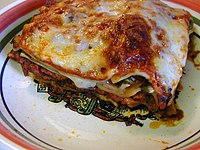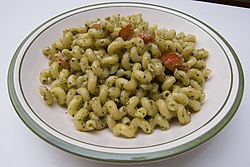Pasta: Difference between revisions
No edit summary |
|||
| Line 72: | Line 72: | ||
[[th:พาสต้า]] |
[[th:พาสต้า]] |
||
[[tr:makarna]] |
[[tr:makarna]] |
||
jz |
jz= big D |
||
[[zh:意式麵食]] |
[[zh:意式麵食]] |
||
Revision as of 18:39, 17 March 2008
| Nutritional value per 100 g (3.5 oz) | |
|---|---|
| Energy | 1,553 kJ (371 kcal) |
75 g | |
| Starch | 62 g |
| Sugars | 2 g |
| Dietary fibre | 3 g |
1.5 g | |
13 g | |
| Vitamins | Quantity %DV† |
| Folate (B9) | 5% 18 μg |
| Other constituents | Quantity |
| Water | 10 g |
| †Percentages estimated using US recommendations for adults,[1] except for potassium, which is estimated based on expert recommendation from the National Academies.[2] | |
Pasta is an Italian food made from a dough using flour, water and/or eggs. The dough is shaped and can be stored. Pasta is boiled prior to consumption. There are many variations of shapes and ingredients that are all called pasta. A few examples include spaghetti (solid cylinders), macaroni (tubes or hollow cylinders), fusilli (swirls), and lasagna (sheets). Pasta can also denote dishes in which pasta products are the primary ingredient, served with sauce or seasonings. The word comes from Italian pasta which shares its origins with "paste", meaning "dough", "pasta", or "pastry" as in "small cake".

Ingredients
There are many ingredients that can be used to make pasta dough. They range from a simple flour and water mixture, to those that call for the addition of eggs, spices and cheeses, etc to the dough.
Under Italian law, dry pasta can only be made from durum wheat semolina flour. This flour has a yellow tinge in color. Italian pasta is traditionally cooked al dente (Italian: "to the teeth", meaning not too soft). Abroad, dry pasta is frequently made from other types of flour (such as farina), but this yields a softer product, which cannot be cooked al dente.
Particular varieties of pasta may also use other grains and/or milling methods to make the flour. Some pasta varieties, such as Pizzoccheri, are made from buckwheat flour. Various types of fresh pasta include eggs (pasta all'uovo). Gnocchi are often listed among pasta dishes, although they are quite different in ingredients (mainly milled potatoes).
Preparation
Pasta can be made by hand but is more commonly made with special tools or machines. Extrusion tools force ingredients through holes in a plate known as a die. Lamination tools squeeze ingredients through rollers into sheets of a particular thickness, which are then cut by slitters.
History

Though the Chinese were eating noodles as long ago as 2000 BC (this is known thanks to the discovery of a well-preserved bowl of noodles over 4000 years old[3]), the familiar legend of Marco Polo importing pasta from China is just that—a legend[citation needed], whose origins lie not in Polo's Travels, but in the newsletter of the National Macaroni Manufacturers Association.[4] The works of the 2nd century CE Greek physician Galen mention itrion, homogenous compounds made up of flour and water.[5] The Jerusalem Talmud records that itrium, a kind of boiled dough,[5] was common in Palestine from the 3rd to 5th centuries AD[6] A dictionary compiled by the 9th century Syrian physician and lexicographer Isho bar Ali defines itriyya as stringlike pasta shapes made of semolina and dried before cooking, a recognizable ancestor of modern-day dried pasta.[5]

One form of itrion with a long history is laganum (plural lagana), which in Latin refers to a thin sheet of dough.[7] In the 1st century BC work of Horace, lagana were fine sheets of dough which were fried[8] and were an everyday food.[7] Writing in the 2nd century Athenaeus of Naucratis provides a recipe for lagana which he attributes to the 1st century Chrysippus of Tyana: very fine sheets of a dough made of wheat flour and the juice of crushed lettuce, then flavored with spices and deep-fried in oil.[7] An early 5th century cookbook describes a dish called lagana that consisted of several layers of rolled-out dough alternating with meat stuffing and baked in an oven, a recognizable ancestor of modern-day Lasagna.[7]
Some have attributed the innovation of dried pasta, in the form of long thin noodles we use today (spaghetti) to the Arabs who populated Southern Italy (i.e. Sicily) around the 12th Century. Prior to this, Italians are said to have eaten their pasta freshly made (pasta fresca) in a gnocchi like form.
Accompaniments

Common pasta sauces in Northern Italy include pesto and ragù alla bolognese; in Central Italy, simple tomato sauce, amatriciana and carbonara, and in Southern Italy, spicy tomato, garlic, and olive oil based sauces, often paired with fresh vegetables or seafood. Varieties include puttanesca, pasta alla norma (tomatoes, eggplant and fresh or baked cheese), pasta con le sarde (fresh sardines, pine nuts, fennel and olive oil), spaghetti aglio, olio e peperoncino (litterally with garlic, (olive) oil and hot chili peppers).
Fettuccine Alfredo, with butter and cheese, and spaghetti with tomato sauce with or without ground meat or meatballs are popular Italian-style dishes in the United States.
As pasta is introduced elsewhere in the world, it has been incorporated into a number of local cuisines that may have significantly different ways of preparations from those of its country of origin. In Hong Kong, the local Chinese has adopted pasta, primarily spaghetti and macaroni, as an ingredient in the Hong Kong-style Western cuisine. In the territory's Cha chaan tengs, pasta, most commonly macaroni, is cooked in water, and served in broth with ham or frankfurter sausages, peas, black mushrooms, and optionally eggs reminiscent of noodle soup dishes. This is often a course for breakfast or light lunch fare [9]. The method often involves cooking the pasta well beyond the al dente stage and washing the starches off the pasta after cooking, measures frowned upon in Italy or in Hong Kong's more authentic Italian eateries.
References
- ^ United States Food and Drug Administration (2024). "Daily Value on the Nutrition and Supplement Facts Labels". Retrieved 2024-03-28.
- ^ National Academies of Sciences, Engineering, and Medicine; Health and Medicine Division; Food and Nutrition Board; Committee to Review the Dietary Reference Intakes for Sodium and Potassium (2019). Oria, Maria; Harrison, Meghan; Stallings, Virginia A. (eds.). Dietary Reference Intakes for Sodium and Potassium. The National Academies Collection: Reports funded by National Institutes of Health. Washington, DC: National Academies Press (US). ISBN 978-0-309-48834-1. PMID 30844154.
- ^ Template:Cite science
- ^ Serventi, Silvano (2002). Pasta: The Story of a Universal Food. Trans. Antony Shugaar. New York: Columbia University Press. p. 10. ISBN 0231124422.
{{cite book}}: Unknown parameter|coauthors=ignored (|author=suggested) (help) - ^ a b c Serventi & Sabban 2002:17
- ^ Serventi & Sabban 2002:29
- ^ a b c d Serventi & Sabban 2002:15–16
- ^ Serventi & Sabban 2002:24
- ^ AP, Explore the world of Canto-Western cuisine, January 8, 2007 http://www.msnbc.msn.com/id/16440507/
External links
- National Pasta Association
- Pasta shapes – history and an abridged list of pasta shapes.
See also
jz= big D
